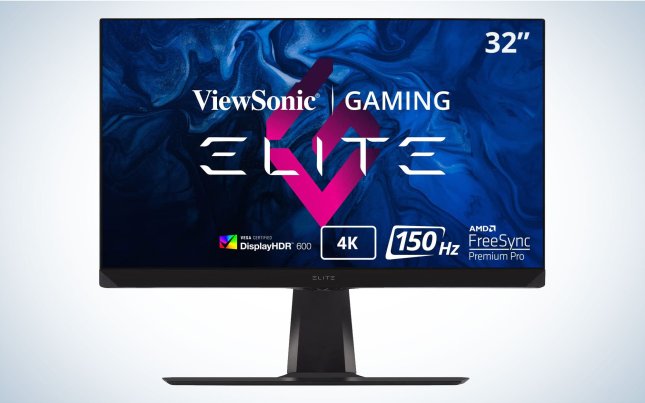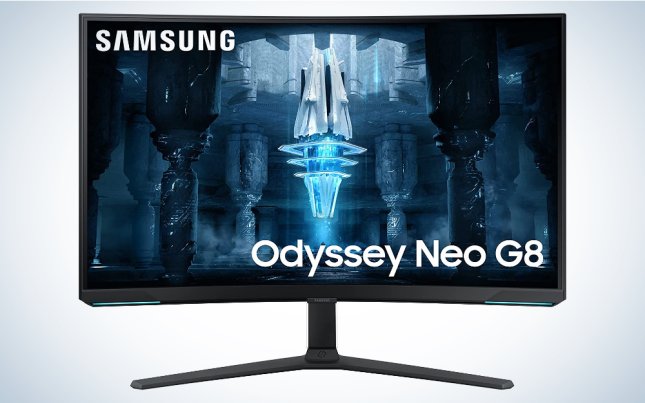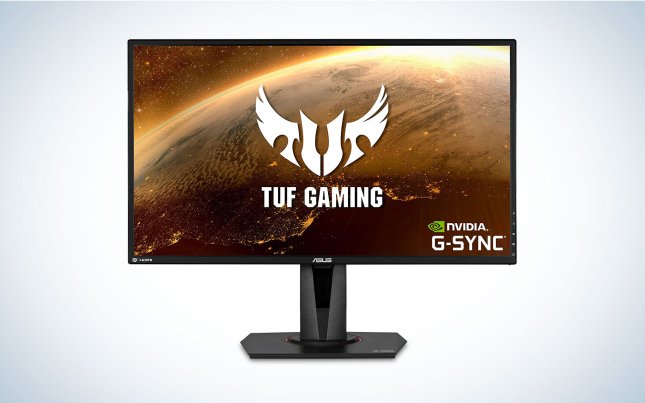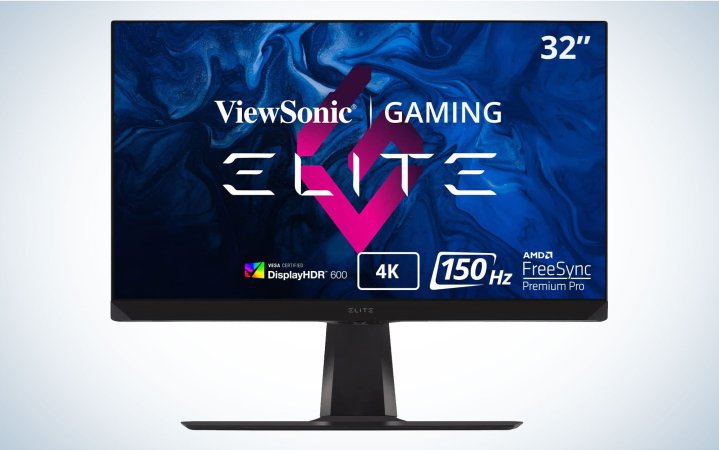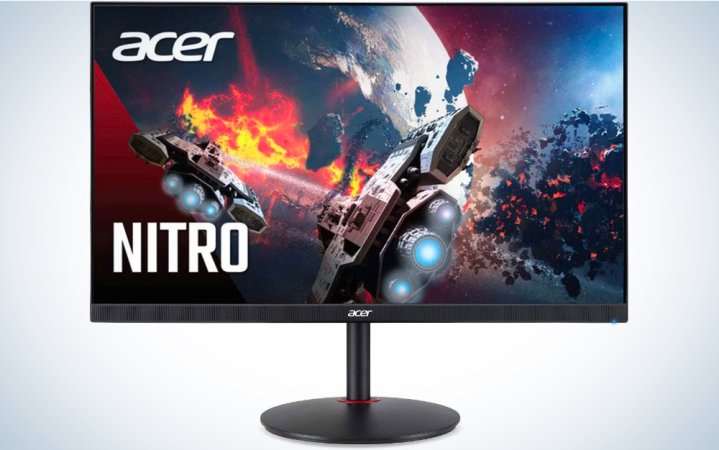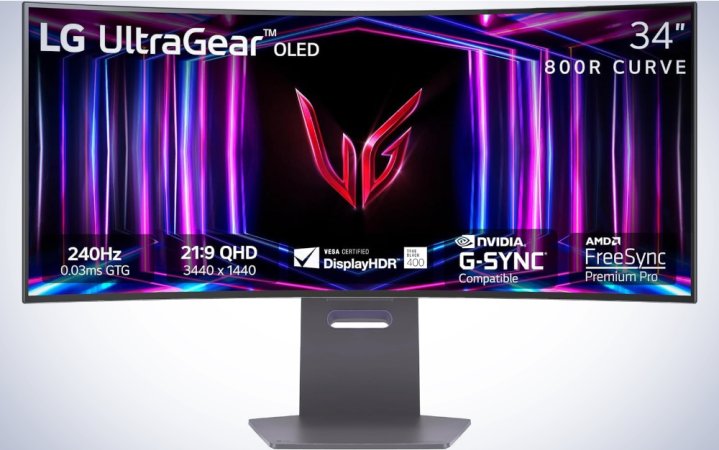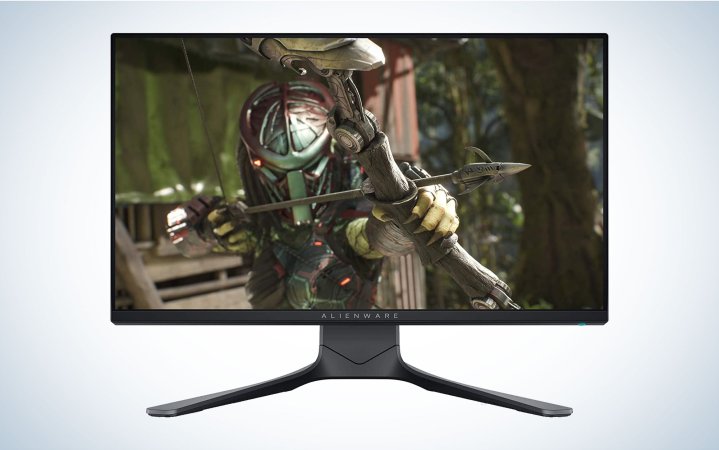We may earn revenue from the products available on this page and participate in affiliate programs. Learn more ›
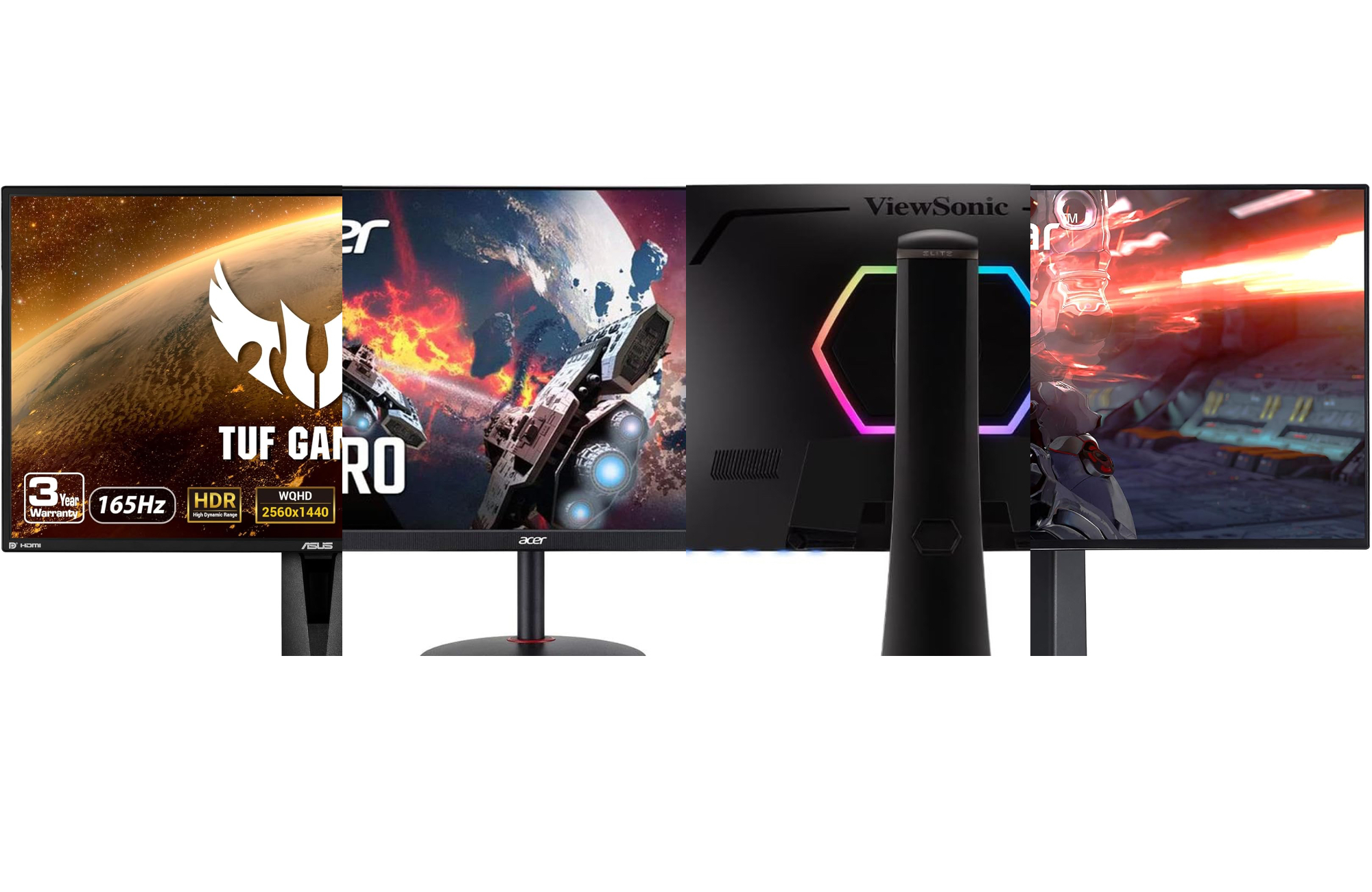
With rare exceptions, modern video games are an extremely visual medium, and what better way to experience that than on one of the top-notch gaming monitors. Whether you want to fully immerse yourself in imaginary worlds or ruthlessly climb to the tops of competitive ladders, crisp, bright, and color-accurate visuals are a key part of that experience. The best gaming monitors can get expensive, but they last for years and can easily jump between systems or become secondary monitors as you upgrade. That said, our best overall pick, the ViewSonic Elite XG320U, should last a long, long time in your main system. There’s little point in spending money on a powerful new console or PC peripherals if you don’t have a screen that can actually take advantage of it. Even if you literally cannot tell the difference between 30 and 60 frames per second or 1080p and 4K (good for you, to be honest), we’ll help you cut through the noise, narrow down your priorities, and match them to one of the best gaming monitors on the market.
- Best overall: ViewSonic Elite XG320U
- Best 4K: Samsung Odyssey Neo G8
- Best 1440p: Acer Nitro XV272U
- Best ultrawide: LG 34GS95QE
- Best for esports: Alienware AW2521HF
- Best curved: Dell Alienware AW3423DW
- Best budget: ASUS TUF Gaming 27-inch 1440P HDR Gaming Monitor (VG27AQ)
How we chose the best gaming monitors
First, we selected a range of specs around which to optimize, broadly dividing up monitors by available categories and user needs, such as focusing on frame rate, resolution, and price-to-spec value. We finalized the specific picks by collating both professional and consumer reviews to confirm monitors that we felt provided the best value in these various specs, with broad and consistent praise. New gaming monitors are coming out all the time, so no list can be truly definitive. However, these selections offer a snapshot of the current state of gaming monitor technology and design.
These selections were also more fundamentally informed by a lifetime of experience as gamers, as well as years covering both the gaming and hardware spaces as journalists and critics. With that expertise, we can help demystify the jargon-heavy world of monitors and help find the best one for you.
The best gaming monitors: Reviews & Recommendations
Flat or curved, big or small, HDMI or DisplayPort or Thunderbolt/USB—it’s time to figure out the best ultrawide monitor for your gaming rig, whether a desktop PC or a laptop. Now that you know the basics, here’s a list of our favorites. Each pick is optimized for a different spec or use case, so we think you’ll find something that works for you.
Best overall: ViewSonic Elite XG320U
Pros
- Gorgeous picture
- Accurate colors out of the box
- High-performing at all resolutions
- HDMI 2.1 compatible
Cons
- Expensive
Why it made the cut: The ViewSonic Elite XG320U offers great performance at the current top end of desktop monitors.
Specs
- Size: 32 inches
- Panel type: IPS
- Native resolution: 4K
- Refresh rate: 150Hz
- Response time: 1ms
- Display ports: DisplayPort, HDMI 2.0, HDMI 2.1
- Variable refresh rate: FreeSync
- HDR: VESA HDR 600
If money is no object and you just want the most monitor in every dimension possible, ViewSonic’s Elite XG320U has everything you need to make your games look their best. IPS (In-Plane Switching) displays historically had more vivid, accurate colors, but at the expense of response time, making them less ideal for gamers. The Elite is a great example of how newer, faster IPS tech has basically eliminated that gap, achieving the best of both worlds with fantastic colors and sharp, responsive images with no ghosting. With HDMI 2.1 compatibility as well, it’s a perfect fit for the latest generation of consoles or PC graphics cards and their promise of 4K gaming at 120Hz.
Best 4K: Samsung Odyssey Neo G8
Pros
- Extremely high refresh rate
- Support for Adaptive Sync with AMD and NVidia graphics cards
- Matte display won’t show glare from lights
Cons
- Price
- Curved display may not be for everyone.
Specs
- Size: 32 inches
- Ports: 2 x HDMI, 2 x USB-A, headphone jack
- Refresh rate: 240Hz
- VESA compatibility: 100 x 100 mm
- Speakers: No
If high-resolution gaming is your main goal—or you want a screen that can, Samsung’s Odyssey Neo G8 is a no-compromise display. Its 240Hz refresh rate will allow you to play titles at their fastest speeds, with the likely bottleneck being your graphics card. A feature called Adaptive Sync will keep gameplay looking smooth whether you’ve got an NVIDIA or AMD graphics card in your rig. Adaptive Sync lowers latency (lag) and reduces or eliminates screen tearing, which is when distortion occurs as the monitor updates what’s being displayed. This feature, combined with the Odyssey Neo G8’s low input lag mode and refresh rate optimizer ensures a smooth experience.
An increasing number of AAA games support HDR (High Dynamic Range), which offers significantly better contrast and color accuracy when played on a TV or monitor with the appropriate hardware. Samsung outfitted the Odyssey Neo G8 with Quantum HDR 2000, so newer games, TV shows, and movies will pop. Games and videos that weren’t mastered with HDR will also look nice, so don’t worry if you spend a lot of time playing the classics.
When you’re not playing games, you’ll appreciate the fact that the Odyssey Neo G8 supports both tilt and height adjustment, so you can find optimal comfort when you’re working or playing. You can also hook the display up to a VESA mount for total control over its positioning. The only issue you may have with this display is its curved screen. The upside is that it’s designed to take up all of your peripheral vision, which is great if you want the most immersive gaming experience. That said, it can get frustrating as curved displays can catch light from multiple angles and reflect it back toward you.
If you have a high-end gaming PC or modern console, Samsung’s Odyssey Neo G8 can be an excellent 4K desk-friendly display. It requires a big up-front investment, but you’ll be rewarded each time you boot up a new title. Play games in a darker environment and willing to sacrifice a few pixels for a more immersive viewing experience? You can explore other backlight technologies. Our favorite ultrawide OLED monitor is also in the Samsung Odyssey G8 family.
Best 1440p: Acer Nitro XV272U
Pros
- Bright, accurate colors
- Responsive performance
- Price
Cons
- Bland design
Why it made the cut: Acer’s Nitro XV272U offers fantastic 1440p performance and utility at a great value.
Specs
- Size: 27 inches
- Panel type: IPS
- Native resolution: 1440p
- Refresh rate: 170Hz
- Response time: .5ms
- Display ports: DisplayPort, HDMI 2.0
- Variable refresh rate: AMD FreeSync
- HDR: VESA HDR 400
Acer’s Nitro XV272U proves that while a monitor’s resolution is important, it’s not everything. This display is 1440p, which means it’s better than HD but not quite 4K. This middle ground is fine since certain consoles, like the Nintendo Switch and Xbox Series S, aren’t capable of playing 4K games anyway. What sets this gaming monitor apart—aside from its shockingly good price is its 170Hz refresh rate, ultra-low latency, and support for AMD’s FreeSync. PC gamers with AMD graphics cards will find the Nitro XV272U is well-suited to their gaming setup. Your PC’s other specs—especially its CPU and GPU—will still make the biggest difference in how your games play, but we’re confident this gaming monitor won’t be the weak link in your system. If you connect your gaming PC to this monitor’s DisplayPort, you’ll have two HDMI ports free for game consoles, which is great if you want to turn your desk into an all-in-one gaming area. If you’re not completely sold on 4K gaming but want a monitor that’s relatively futureproofed for when you upgrade your gaming hardware, Acer’s Nitro XV272U is a great choice.
Best ultrawide: LG 34GS95QE
Pros
- OLED Panel
- Ergonomically sound
- Support for both G-Sync and FreeSync
Cons
- Low brightness
Why it made the cut: The LG 34GS95QE has all the big bells and whistles we look for without the heavy price tag.
Specs
- Size: 34 inches
- Panel type: OLED
- Native resolution (Aspect Ratio): 3440×1440
- Refresh rate: 240 Hz
- Response time: .03ms
- Display ports: 1 x DisplayPort 1.4; 1 x HDMI 2.0; 2 x USB 3.0 Type-A
- Variable refresh rate: Nvidia G-Sync Compatible/FreeSync Premium Pro
- HDR: HDR10, VESA HDR 400
LG’s 34GS95QE is more than just the best ultrawide monitor for gaming. Its OLED panel will deliver perfect contrast, which IPS and VA panel displays cannot match. Its 240Hz maximum refresh rate will allow you to push games to their limits, and signifies the monitor can be updated with new information up to twice as fast as other displays. Similarly, its astonishingly low .03ms response time will allow you to make moves with pinpoint precision and watch the actions you perform play out in nearly real-time. This display’s relatively dim maximum brightness is its only notable technical fault.
One of LG’s best decisions was to design the 34GS95QE with support for both NVIDIA G-Sync and AMD FreeSync Premium Pro, which ensures you’ll have a top-tier experience regardless of the graphics card you have. You’ll also be able to switch platforms in the future without taking a performance hit or having to shell out for a new display. Console gamers can take advantage of HDR gaming at 120 frames per second provided the titles you’re playing support ultra-high framerates. Be mindful that this is an ultra-widescreen display, which means it’ll require a significant amount of desk space, and many console games have not been updated to support this display’s aspect ratio.
The 34GS95QE is equipped with both DisplayPort 1.4 and HDMI 2.1 ports. If you’re connecting your PC or console to it using an HDMI cable, make sure to get one that supports data transfer speeds of 48Gbps (Gigabits per second). Some cables top out at 18Gbps, which isn’t enough bandwidth to send a 4K HDR signal at 120 or 240Hz. If you plan on playing games for several hours at a time, you’ll appreciate the fact that this monitor is height and tilt adjustable, so you can move it around throughout the day. You can also hook the 34GS95QE up to a VESA arm if you’d prefer having total control over its positioning. If you’re considering ultrawide gaming monitor for the first time or upgrading from a previous model, LG’s 34GS95QE is the first one to consider.
Best for esports: Alienware AW2521HF
Pros
- 240Hz refresh rate
- Great viewing angles
- Support for both G-Sync and FreeSync
Cons
- No HDR
Why it made the cut: A small display with a 240Hz framerate, the Alienware AW2521HF is optimized for competitive play in all the right ways.
Specs:
- Size: 24.5 inches
- Panel type: IPS
- Native resolution: 1080p
- Refresh rate: 240Hz
- Response time: 1ms
- Display ports: HDMI 2.0, DisplayPort
- Variable refresh rate: G-Sync, FreeSync
- HDR: N/A
When it comes to fast-paced online competition, speed is the most important variable. Alienware’s AW2521HF 24.5-inch IPS display is only 1080p but runs at a blistering 240Hz with a low 1ms response time. Although it lacks HDR, it has fantastic viewing angles and is extremely glare-resistant, helping you maintain focus on the game. It’s compatible with both AMD FreeSync and NVIDIA G-Sync, meaning smooth performance no matter what graphics card is powering it.
Best curved: Dell Alienware AW3423DW
Pros
- QD-OLED panel enables incredible contrast and sharpness
- 1000-nits peak brightness
- Quantum dots for rich, accurate colors
- G-Sync Ultimate
Cons
- Very expensive
- Doesn’t work well with PS5
- No HDMI 2.1 ports
Why it made the cut: The Alienware AW3423DW’s fast, color-rich OLED screen makes games look better than ever; it’s expensive but very impressive.
Specs
- Screen size: 34.18-inch (Ultrawide)
- Panel type: QD-OLED
- Native resolution: 3440×1440
- Refresh rate: 175Hz
- Response time: 0.1ms
- Display ports: DisplayPort, HDMI 2.0
- Variable refresh rate: G-Sync
- HDR: DisplayHDR 400 True Black
The Alienware AW3423DW is the rare curved display that features a Quantum Dot-enhanced OLED panel. Standard OLED screens lack the brightness of conventional LCD displays, but Quantum Dot technology increases the screen’s base brightness, which allows the AW3423DW to hit an HDR-bright 1000 nits. It only achieves that maximum brightness in select spots on the monitor but is still more than capable of generating quality HDR gameplay. It will not hit this maximum brightness when playing non-HDR enabled games, though, so be mindful of that if you play a lot of older titles.
The AW3423DW has a ridiculously fast 0.1ms response time, so ghosting (seeing old images while your monitor refreshes with new information) isn’t an issue for this display. These artifacts can drag down your gaming experience, and playing without them will make a significant difference if you’re coming from an older monitor. This external monitor’s 175Hz refresh rate and support Nvidia’s G-Sync Ultimate ensure excellent picture quality without screen tearing.
However, the AW3423DW console players who would pair it with a PlayStation 5 will run into issues due to its lack of HDMI 2.1 ports, which will disallow you from playing games in 4K at 120Hz using an HDMI cable. It also can’t downscale 4K content, so the PS5 will only run in 1080p. Luckily, there are monitors that’re particularly well-suited to PS5.
The Alienware AW3423DW is one of a few notable OLED gaming monitors in 2024. That said, the distinctive, high-performance panel comes with a very steep price tag. If you’re a PC player who wants to see the sharpest possible picture on a monitor, it’s a splurge-worthy investment.
Best budget: ASUS TUF Gaming 27-inch 1440P HDR Gaming Monitor (VG27AQ)
Pros
- 1440p and high refresh rate
- Good ergonomic options
- Incredible value for spec
Cons
- Weak HDR
Why it made the cut: The Asus TUF VG27AQ delivers incredible performance for under $400.
Specs
- Size: 27 inches
- Panel type: IPS
- Native resolution: 1440p
- Refresh rate: 165Hz
- Response time: 1ms
- Display ports: 1 x DisplayPort, 2 x HDMI 2.0
- Variable refresh rate: G-Sync, FreeSync
- HDR: HDR10
It’s hard to find a better performance-to-price ratio than ASUS’ TUF Gaming VG27AQ. At 27 inches, 1440p, 165Hz, and a 1ms response time, this relatively cheap monitor means you’re ready for both visually rich immersion and lightning-speed competition. It even features ergonomic adjustments like height, tilt, and swivel, often one of the first sacrifices you make for a cheaper monitor. The only substantial drawback is that the overall brightness is insufficient to really let the HDR pop. Still, sacrifices had to be made somewhere for such an otherwise excellent monitor and our best value pick.
What to look for when choosing the best gaming monitor
When researching gaming monitors, companies will throw a lot of numbers at you. Some of these specs—like size, resolution, and refresh rate—are extremely important. Others are a bit more granular. Here’s a rundown of the top details to watch before you pick up your next display.
Size and resolution
Many PC gamers believe bigger is better, but that isn’t always true. Size, resolution, and where you sit relative to the monitor are all intimately connected, and you should consider them all together when picking the best gaming monitor for you. A monitor’s size, listed in inches, refers to the diagonal length from corner to corner. PC monitors typically range from 19 to 34 inches.
Resolution refers to the number of pixels on the screen, given in width by height. For gaming monitors, the three relevant contemporary resolutions are 1920 x 1080 (“1080p” or “HD”), 2560 x 1440 (“1440p” or “Quad HD”), and 3840 x 2160 (“4K” or “Ultra HD/UHD”). More pixels mean more detailed images, but also demand much more of your graphics card, so one of the biggest limiting factors for your monitor purchase should be the resolution at which your hardware can comfortably operate (unless you are trying to futureproof for some later upgrade). The benefits of more pixels are also lost on smaller monitors, where you won’t really be able to see the difference. For a small monitor—anything less than 27 inches—stick with 1080p. For 27- to 30-inch monitors, you probably want 1440p. For monitors larger than 30 inches, 4K is ideal.
Where you sit also factors in because being closer to a screen means it fills more of your vision, effectively making it larger. A 32-inch monitor might be great in theory, but if it’s dominating your desk, you might strain your neck trying to take it all in. Ergonomics experts recommend that the top of the monitor should sit around your eye level, so you minimize strain from having to look up at it, so keep that in mind when measuring your space. There’s no one best setup for size and resolution, so you should weigh both your hardware’s power and the setting in which you’ll be using it to pick the configuration that will give you the most bang for your buck
Refresh rate and response time
Refresh rate and response time are hugely important when it comes to finding the best gaming monitor. A refresh rate, expressed in Hertz (Hz), tells you the maximum number of times your monitor can update the status of what’s happening on your PC per second. In games, that translates to the game’s frame rate, or how many frames of animation your screen can show. The higher the refresh rate, the better and smoother the image. Refresh rates can range from 30Hz to 300Hz, but you’ll most commonly see 60Hz, 144Hz, and 240Hz. For modern AAA gaming, we generally recommend a 140Hz monitor. Still, there are exceptions: For esports, many players will choose the highest possible refresh rate to have the best reaction time, even at the expense of resolution and screen size. On the opposite end, 4K monitors are not as ubiquitous as 4K TVs and are still very expensive, so you may find yourself picking out a 4K/60fps model if the resolution is a priority for you.
In addition to a high refresh rate, you want to find a monitor with a short response time. Response time measures how quickly the monitor can change a pixel from black to white (or through shades of gray, depending on the monitor type). A longer response time means more motion blur, which can really mess up gameplay. Most monitors feature a 1ms response time, which is acceptable. There’s often more variation than the manufacturer’s letting on, but for this crash course, 1mm is good enough for most people.
Variable refresh rate
One very common feature worth highlighting is “variable refresh rate,” which refers to a monitor’s ability to smoothly ramp the frame rate up and down on the fly to match hardware performance. This leads to smoother visuals, specifically reducing the screen stuttering and tearing that can sometimes happen in video games, particularly when visuals are intense. There are two major versions of this technology: Nvidia’s proprietary G-Sync, and competitor AMD’s more open FreeSync technology. While some monitors are compatible with both, many only support one or the other, so if your machine’s graphics card can support it (depending on whether Nvidia or AMD makes it), be sure and get a compatible monitor to enjoy the benefits.
Do you want a curved monitor for gaming?
Curved monitors—which create a more immersive experience by allowing you to use your full field of view, including your peripheral vision—have become increasingly popular in gaming circles. Though they come in all shapes and sizes, they typically need to be large to create a wide field of view and often come in “ultrawide” screen sizes to maximize their effects.
When picking a curved display, you need to look at the depth of the curve, in addition to the usual size and resolution specs. The Monitor curvature, expressed as R, tells you the radius of the monitor’s curve. The number typically ranges from 1000R to 4000R. The lower the number, the deeper the curve. According to monitor manufacturer ViewSonic, the number also serves as a quick reference for how far away you should position yourself from your monitor. If you have a 4000R monitor, you should also sit 4 meters away from the monitor when you play to minimize eye fatigue and to get the best viewing experience.
The curved monitor can be a very cool way to enhance your games, but it is an “advanced” purchase for PC-savvy players who really know what they want. Many games require extra settings adjustments to work properly on wider curved displays. Also, picking a curved display usually means committing to a one-display setup since your curved monitor has to be centered. That may not fit players who work from home and use their PCs for work and play. If you’re into monitors and optimizing your experience, buying one may be life-changing, but new PC gamers might want to start with a flat panel and work their way up to it.
FAQs
Yes, given that 60 frames per second is still the industry-standard stable target, 165Hz gives you lots of room to handle the fastest any game will run. We generally recommend 144Hz displays for most players, unless you’re specifically looking for an u0022esports monitoru0022 to give you an edge in competitive play.
While it is ultimately a matter of taste, most would describe 32-inch monitors as the upper limit for a comfortable gaming experience. Depending on how close you like to sit to your screen, a 30- or 32-inch monitor may require you to move your neck to see the far corners of the screen, leading to fatigue and strain over time.
Also, it bears repeating that as size goes up pixel density goes down, so a 32-inch 1080p display will look worse than a smaller screen with the same specs. At that size, you should primarily look for 4K displays.
Yes, a 240Hz monitor will offer a higher level of fidelity than an external display with a lower refresh rate. That said, most games can’t run at 120FPS, and wouldn’t be able to take full advantage of the added speed.
No, gaming is a single-screen pursuit—unless you’re playing on Nintendo’s DS, 3DS, or WiiU platforms—so two gaming monitors aren’t necessary. If you’re planning on streaming your gameplay on Twitch, and want to keep an eye on your chat, a second non-gaming-specific monitor could be a good option.
Yes. Playing games on multiple monitors would impact your GPU performance since resources would have to be split between them.
OLED panels would offer the best color performance, but that screen technology hasn’t made its way into the mainstream gaming monitor world. A few OLED options exist, but they’re few and far between.
The FPS (First Person Shooter) genre of games benefit most from faster display panels, so any gaming monitor with a 240Hz refresh rate would work best.
This will depend on its size, resolution, and refresh rate. An entry-level gaming monitor shouldn’t cost more than $250, but you can spend upwards of $1500 if you want a cutting-edge external display.
Esports pros usually prefer smaller monitors than casual gamers because they minimize the effort required to take in the entire screen. Being able to process information quickly is one of the most fundamental skills in any competitive video game, and 24 inches is the standard size that tends to best fill their field of vision without overwhelming it. When playing video games is your job, tiny ergonomic factors are dramatically amplified, so comfort and utility take precedence over aesthetic immersion.
Final thoughts on the best gaming monitors
- Best overall: ViewSonic Elite XG320U
- Best 4K: Samsung Odyssey Neo G8
- Best 1440p: Acer Nitro XV272U
- Best for esports: Alienware AW2521HF
- Best curved: Samsung Odyssey G9
- Best budget: ASUS TUF Gaming 27-inch 1440P HDR Gaming Monitor (VG27AQ)
The best gaming monitor is designed to fit your space, enhance your gaming experience, and elevate the visuals of your favorite games. As long as you feel confident about the way you hope to play and the setup that you want, we feel confident you’ll be able to find the perfect fit. Don’t skimp on scoping out the specs, and stick to your goals, even if that means waiting a little more time to save. The next best monitor for gaming is always right around the corner, so make sure you are super satisfied with your choice.
